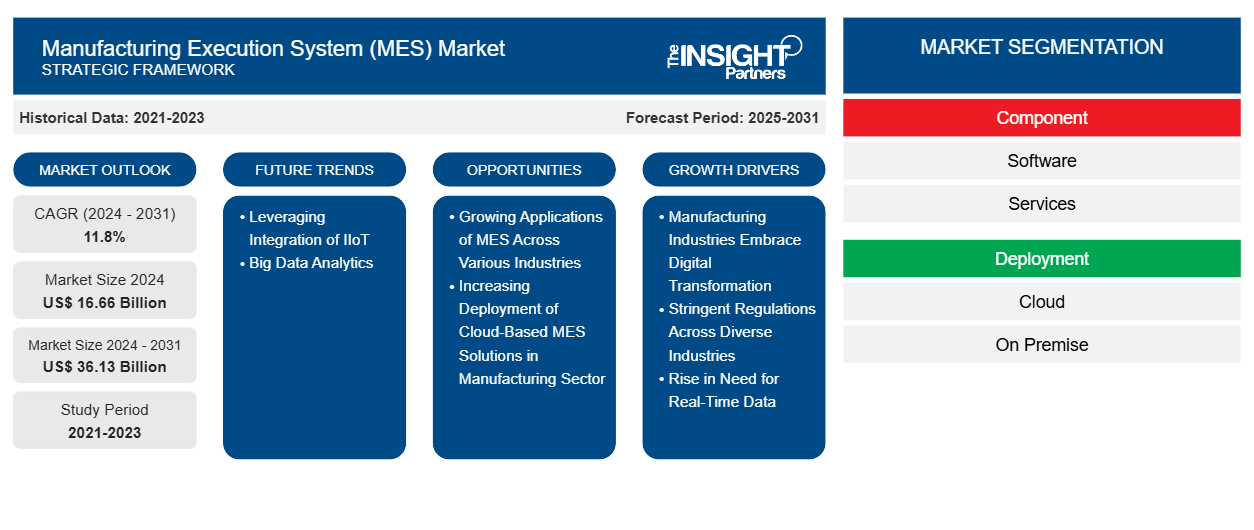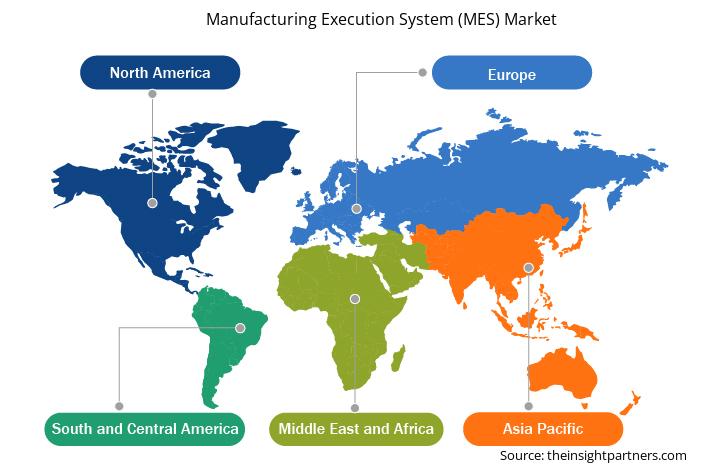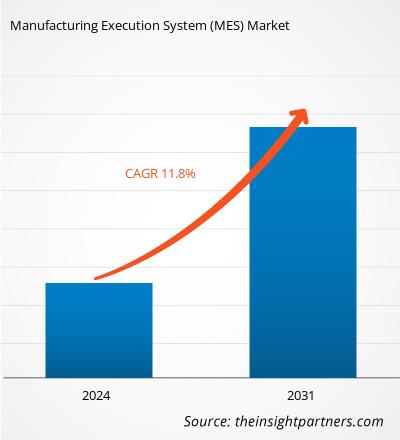제조 실행 시스템(MES) 시장 규모는 2024년에 166억 6천만 달러로 평가되었으며 2031년까지 361억 3천만 달러에 도달할 것으로 예상되며 2024~2031년 동안 11.8%의 CAGR을 기록할 것으로 추산됩니다. IIoT와 빅데이터 분석의 통합을 활용하는 것이 주요 시장 추세로 남을 가능성이 높습니다.
제조 실행 시스템(MES) 시장 분석
디지털 혁신을 시작하는 제조 산업, 다양한 산업의 엄격한 규제, 실시간 데이터에 대한 증가하는 요구와 같은 요인이 제조 실행 시스템(MES) 시장 의 성장을 주도하고 있습니다 . 다양한 산업에서 MES 사용이 증가하고 제조에서 클라우드 기반 MES 솔루션이 증가함에 따라 제조 실행 시스템(MES) 시장이 확대될 수 있는 기회가 생길 것으로 예상됩니다. 또한 IIoT와 빅데이터 분석을 통합하면 제조 실행 시스템(MES) 시장에 새로운 트렌드가 생길 것으로 예상됩니다.
제조 실행 시스템(MES) 시장 개요
제조 실행 시스템(MES)은 원자재에서 완제품에 이르기까지 전체 제조 프로세스를 모니터링, 추적, 문서화 및 관리하는 포괄적이고 역동적인 소프트웨어 시스템입니다. MES는 ERP(Enterprise Resource Planning)와 프로세스 제어 시스템 사이의 기능적 계층 역할을 하며, 의사 결정권자에게 공장 현장 효율성을 개선하는 데 필요한 데이터를 제공합니다. MES를 통해 기업은 원자재 섭취에서 완제품 납품까지 전체 제조 프로세스를 추적하고 제어할 수 있습니다 . 여기에는 작업 주문 처리, 제품 품질 확인, 기계 성능 모니터링 및 생산 프로세스 전반에 걸친 데이터 수집이 포함됩니다.
MES 소프트웨어는 원자재를 중간 및/또는 완제품으로 전환하는 데 관련된 실시간 물리적 프로세스와 인력을 관리, 모니터링 및 조정하는 데 사용됩니다. 또한, 생산 의사 결정권자가 생산량을 늘리기 위해 플랜트 바닥 운영 조건을 최적화하는 방법을 이해하는 데 도움이 되는 실행 가능한 데이터를 제공합니다. MES 소프트웨어는 PLM, ERP 시스템(IT), 기계(OT) 간의 브리지 역할을 합니다. 이 소프트웨어 계층은 생산 프로세스의 효율성과 품질을 개선하여 생산성과 수익성을 높입니다.
귀하의 요구 사항에 맞게 이 보고서를 사용자 정의하세요
이 보고서의 일부 또는 국가 수준 분석, Excel 데이터 팩을 포함하여 모든 보고서에 대한 사용자 정의를 무료로 받을 수 있으며 신생 기업 및 대학을 위한 훌륭한 혜택과 할인 혜택을 이용할 수 있습니다.
제조 실행 시스템(MES) 시장: 전략적 통찰력

-
이 보고서의 주요 시장 동향을 알아보세요.이 무료 샘플에는 시장 동향부터 추정 및 예측까지 다양한 데이터 분석이 포함됩니다.
제조 실행 시스템(MES) 시장 동인 및 기회
다양한 산업에 걸친 엄격한 규정
MES는 완벽한 추적성과 데이터 기록을 통해 산업 규정 준수를 보장합니다. 제조에 관련된 원재료, 구성 요소, 프로세스 및 운영자에 대한 광범위한 정보를 기록합니다. 이 데이터를 통해 제조업체는 규제 기준을 충족하고 높은 표준을 유지할 수 있습니다. 예를 들어, MES는 제조 프로세스의 각 단계를 자동으로 문서화하여 규제 검사에 필요한 감사 추적을 생성할 수 있습니다. 또한 실시간으로 품질 관리 매개변수를 분석하여 제품이 산업 표준을 충족하는지 확인합니다. 편차가 발생하면 MES에서 경고를 보내고 시정 조치를 취하여 규정 준수를 보장할 수 있습니다. MES는 제약 분야의 일상 업무의 중추로, 제조 프로세스의 모든 측면을 정확하고 실시간으로 관리할 수 있습니다. 제약 산업에서 MES는 엄격한 GMP(Good Manufacturing Practice) 기준에 따라 전자 배치 기록(EBR)을 용이하게 합니다. MES는 EBR 시스템을 배포하여 각 생산 단계가 정확하게 문서화되도록 하여 인적 실수의 위험을 낮추고 일상 업무 관리를 간소화합니다. 또한 식품 및 음료 산업의 MES는 HACCP(위험 분석 및 중요 관리 지점)를 포함한 모든 법적 및 위생 표준을 충족합니다. 식품 및 음료 산업에서 MES를 배치하는 것은 단계적으로 수행하는 것이 가장 좋으며, 제조 공정의 중단을 최소화하기 위해 선택한 제조 라인이나 구역에서 시작합니다. 따라서 다양한 산업에 걸친 엄격한 규제 기준이 제조 실행 시스템(MES) 시장 성장을 촉진합니다.
다양한 산업에 걸쳐 MES의 응용 프로그램 확대
MES 솔루션은 자동차, 전자, 제약과 같은 다양한 산업의 특정 요구 사항을 충족하도록 구현 및 수정할 수 있습니다. 동시에 MES의 기본 기능은 산업 전반에서 동일하게 유지됩니다. 제조 실행 시스템(MES) 솔루션은 점점 더 복잡하고 빠르게 변화하는 자동차 산업에 발맞추고 제조 운영을 시장 요구 사항에 더 잘 맞추는 데 도움이 될 수 있습니다. MES는 운영 관리, 정보 관리, 통합 게이트웨이의 세 가지 핵심 기능을 사용하여 이를 달성합니다. MES를 사용하면 자동차 공급업체가 변화하는 산업 동향을 앞서 나가는 데 도움이 될 수 있습니다. 자동차 제조에서 MES는 복잡한 조립 라인을 조정하는 데 중요한 역할을 합니다. MES는 조립 라인에서 차량의 진행 상황을 추적하고, 구성 요소의 가용성을 모니터링하고, 여러 작업 스테이션에서 작업을 동기화합니다. 배터리 제조업체는 혼합에서 제형까지 전체 추적성을 확보하여 품질 관리를 개선할 수 있습니다. 타이어 제조업체는 복잡한 타이어 혼합물을 관리하면서 효율성과 품질 표준을 유지할 수 있습니다. MES는 여러 영역에서 정량화 가능한 개선을 제공할 수 있습니다. Rockwell Automation에 따르면 MES는 폐기물을 최대 8%, 리드 타임을 최대 45%, 사이클 타임을 최대 45%, 인건비를 최대 50%, 불량률을 최대 75%까지 줄일 수 있습니다. 이로 인해 다양한 산업에 적용되고 있습니다. 따라서 다양한 산업에 걸쳐 MES가 확대 적용됨에 따라 시장 성장에 수익성 있는 기회가 창출될 것으로 예상됩니다.
제조 실행 시스템(MES) 시장 보고서 세분화 분석
제조 실행 시스템(MES) 시장 분석에 기여한 주요 세그먼트는 구성 요소, 배포, 조직 규모, 라이센스 유형, 판매 채널 및 최종 사용자입니다.
- 구성 요소를 기준으로 시장은 소프트웨어와 서비스로 세분화됩니다. 서비스 세그먼트는 전문 서비스와 관리 서비스로 더 세분화됩니다. 소프트웨어 세그먼트는 2024년에 시장을 지배했습니다.
- 배포 측면에서 시장은 온프레미스와 클라우드로 세분화됩니다. 클라우드 세그먼트는 프라이빗 클라우드, 퍼블릭 클라우드, 하이브리드 클라우드로 세분화됩니다. 클라우드는 2024년에 가장 큰 시장 점유율을 차지했습니다.
- 제조 실행 시스템(MES) 시장은 조직 규모에 따라 대기업과 중소기업으로 나뉩니다. 대기업 세그먼트는 2024년에 시장을 지배했습니다.
- 라이선스 유형에 따라 제조 실행 시스템(MES) 시장은 라이선스 기반과 구독 기반으로 세분화됩니다. 구독 기반 세그먼트는 2024년에 시장을 지배했습니다.
- 판매 채널을 기준으로 시장은 직접 판매, 채널 파트너, 제3자 공급업체로 분류됩니다. 직접 판매 부문은 2024년에 시장을 지배했습니다.
- 최종 사용자를 기준으로 시장은 프로세스 산업과 이산 산업으로 세분화됩니다. 프로세스 산업 세그먼트는 식품 및 음료, 석유 및 가스, 화학, 펄프 및 제지, 화학, 에너지 및 전력, 제약 및 생명 과학, 수질 및 폐수 처리 및 기타로 더 세분화됩니다. 이산 산업 세그먼트는 자동차, 전자, 반도체, 항공우주 및 방위, 소비자 포장 상품, 의료 기기 및 기타로 더 세분화됩니다. 이산 산업 세그먼트는 2024년에 시장을 지배했습니다.
지리적 지역별 제조 실행 시스템(MES) 시장 점유율 분석
- 제조 실행 시스템(MES) 시장은 북미, 유럽, 아시아 태평양(APAC), 중동 및 아프리카(MEA), 남미 및 중미의 5개 주요 지역으로 구분됩니다. 북미는 2024년에 제조 실행 시스템(MES) 시장을 지배했습니다. 유럽은 글로벌 제조 실행 시스템(MES) 시장에 두 번째로 큰 기여자이며, 그 다음은 아시아 태평양입니다.
- 북미의 제조 실행 시스템(MES) 시장은 미국, 캐나다, 멕시코로 구분됩니다. 북미는 이 지역의 첨단 제조 기반과 Industry 4.0 기술의 조기 도입에 힘입어 상당한 제조 실행 시스템(MES) 시장 점유율을 보유하고 있습니다. 특히 미국은 Rockwell Automation과 Honeywell International Inc.와 같은 글로벌 리더를 포함한 많은 MES 소프트웨어 공급업체의 본거지입니다. 북미의 MES 도입은 자동차, 항공우주, 제약, 전자와 같은 산업 전반에 걸쳐 널리 퍼져 있습니다. 실시간 데이터 분석, 생산 효율성, 규정 준수에 대한 강조가 커지면서 MES 솔루션에 대한 수요가 증가하고 있습니다. 게다가 제조업체와 정부 당국이 실시간 생산 모니터링과 프로세스 최적화의 이점을 점점 더 인식함에 따라 북미 시장은 상당한 성장을 목격하고 있습니다. 또한 디지털 혁신과 Industry 4.0 도입에 대한 정부 인센티브로 인해 MES 시스템에 대한 수요가 가속화되어 시장 성장이 더욱 촉진되고 있습니다.
제조 실행 시스템(MES) 시장 지역 통찰력
Insight Partners의 분석가들은 예측 기간 동안 제조 실행 시스템(MES) 시장에 영향을 미치는 지역적 추세와 요인을 철저히 설명했습니다. 이 섹션에서는 북미, 유럽, 아시아 태평양, 중동 및 아프리카, 남미 및 중미의 제조 실행 시스템(MES) 시장 세그먼트와 지리적 분포도 논의합니다.

- 제조 실행 시스템(MES) 시장에 대한 지역별 특정 데이터 얻기
제조 실행 시스템(MES) 시장 보고서 범위
| 보고서 속성 | 세부 |
|---|---|
| 2024년 시장 규모 | 166억 6천만 달러 |
| 2031년까지 시장 규모 | 361억 3천만 달러 |
| 글로벌 CAGR (2024-2031) | 11.8% |
| 역사적 데이터 | 2021-2023 |
| 예측 기간 | 2025-2031 |
| 다루는 세그먼트 |
구성 요소별로
|
| 포함된 지역 및 국가 |
북아메리카
|
| 시장 선도 기업 및 주요 회사 프로필 |
|
제조 실행 시스템(MES) 시장 참여자 밀도: 비즈니스 역학에 미치는 영향 이해
제조 실행 시스템(MES) 시장은 소비자 선호도의 변화, 기술 발전, 제품의 이점에 대한 인식 증가와 같은 요인으로 인해 최종 사용자 수요가 증가함에 따라 빠르게 성장하고 있습니다. 수요가 증가함에 따라 기업은 제품을 확장하고, 소비자의 요구를 충족하기 위해 혁신하고, 새로운 트렌드를 활용하여 시장 성장을 더욱 촉진하고 있습니다.
시장 참여자 밀도는 특정 시장이나 산업 내에서 운영되는 회사나 기업의 분포를 말합니다. 주어진 시장 공간에 얼마나 많은 경쟁자(시장 참여자)가 존재하는지 그 규모나 총 시장 가치에 비해 나타냅니다.
제조 실행 시스템(MES) 시장에서 운영되는 주요 회사는 다음과 같습니다.
- SAP SE
- ABB 유한회사
- 다쏘시스템 SE
- 슈나이더 일렉트릭 SE
- 에머슨 일렉트릭 주식회사
- 제너럴 일렉트릭(주)
면책 조항 : 위에 나열된 회사는 어떤 특별한 순서에 따라 순위가 매겨지지 않았습니다.

- 제조 실행 시스템(MES) 시장 주요 주요 업체 개요를 알아보세요
제조 실행 시스템(MES) 시장 뉴스 및 최근 개발
제조 실행 시스템(MES) 시장은 1차 및 2차 조사 후 질적, 양적 데이터를 수집하여 평가합니다. 여기에는 중요한 기업 간행물, 협회 데이터 및 데이터베이스가 포함됩니다. 제조 실행 시스템(MES) 시장의 몇 가지 개발 사항은 다음과 같습니다.
- Emerson Automation Solutions는 Informetric Systems Inc.와의 파트너십을 확대했다고 발표했습니다. Emerson은 InfoBatch를 Syncade Manufacturing Execution System과 통합했습니다. Emerson 고객은 이제 InfoBatch 보고 제품군을 사용하여 Syncade, DeltaV 및 타사 데이터베이스/역사가의 데이터를 집계할 수 있습니다.
(출처: Emerson Automation Solutions, 보도자료, 2024년 11월)
- GE Vernova의 에너지 사업 포트폴리오에 필수적인 부분인 GE Digital은 2월 6일부터 9일까지 플로리다 올랜도에서 열린 제27회 연례 ARC Industry Forum에서 Proficy Smart Factory 포트폴리오의 클라우드 기반 제조 실행 시스템(MES) 소프트웨어에 대한 새로운 개선 사항을 발표했습니다. 온프레미스 구현에 비해 자본 지출(CAPEX)과 운영 비용(OPEX)을 낮추는 Proficy Smart Factory 클라우드 MES 소프트웨어는 모든 규모의 프로세스, 분산 및 혼합 환경 제조업체가 총 소유 비용(TCO)을 최대 30%까지 줄이고 유지 관리를 줄이며 보안을 개선하는 데 도움이 될 수 있습니다.
(출처: GE Digital, 보도자료, 2023년 2월)
제조 실행 시스템(MES) 시장 보고서 범위 및 제공물
"제조 실행 시스템(MES) 시장 규모 및 예측(2021-2031)"은 아래에 언급된 영역을 포괄하는 시장에 대한 자세한 분석을 제공합니다.
- 범위에 포함된 모든 주요 시장 세그먼트에 대한 글로벌, 지역 및 국가 수준의 제조 실행 시스템(MES) 시장 규모 및 예측
- 제조 실행 시스템(MES) 시장 동향 및 동인, 제약, 주요 기회와 같은 시장 역학
- 자세한 PEST 및 SWOT 분석
- 주요 시장 동향, 글로벌 및 지역 프레임워크, 주요 업체, 규정 및 최근 시장 개발 사항을 포괄하는 제조 실행 시스템(MES) 시장 분석
- 시장 집중도, 히트맵 분석, 유명 업체 및 제조 실행 시스템(MES) 시장의 최근 개발 사항을 다루는 산업 환경 및 경쟁 분석
- 자세한 회사 프로필
- 과거 분석(2년), 기준 연도, CAGR을 포함한 예측(7년)
- PEST 및 SWOT 분석
- 시장 규모 가치/거래량 - 글로벌, 지역, 국가
- 산업 및 경쟁 환경
- Excel 데이터세트
최근 보고서
사용 후기
구매 이유
- 정보에 기반한 의사 결정
- 시장 역학 이해
- 경쟁 분석
- 고객 인사이트
- 시장 예측
- 위험 완화
- 전략 기획
- 투자 타당성 분석
- 신흥 시장 파악
- 마케팅 전략 강화
- 운영 효율성 향상
- 규제 동향에 발맞춰 대응






















 무료 샘플 받기 - 제조 실행 시스템(MES) 시장
무료 샘플 받기 - 제조 실행 시스템(MES) 시장